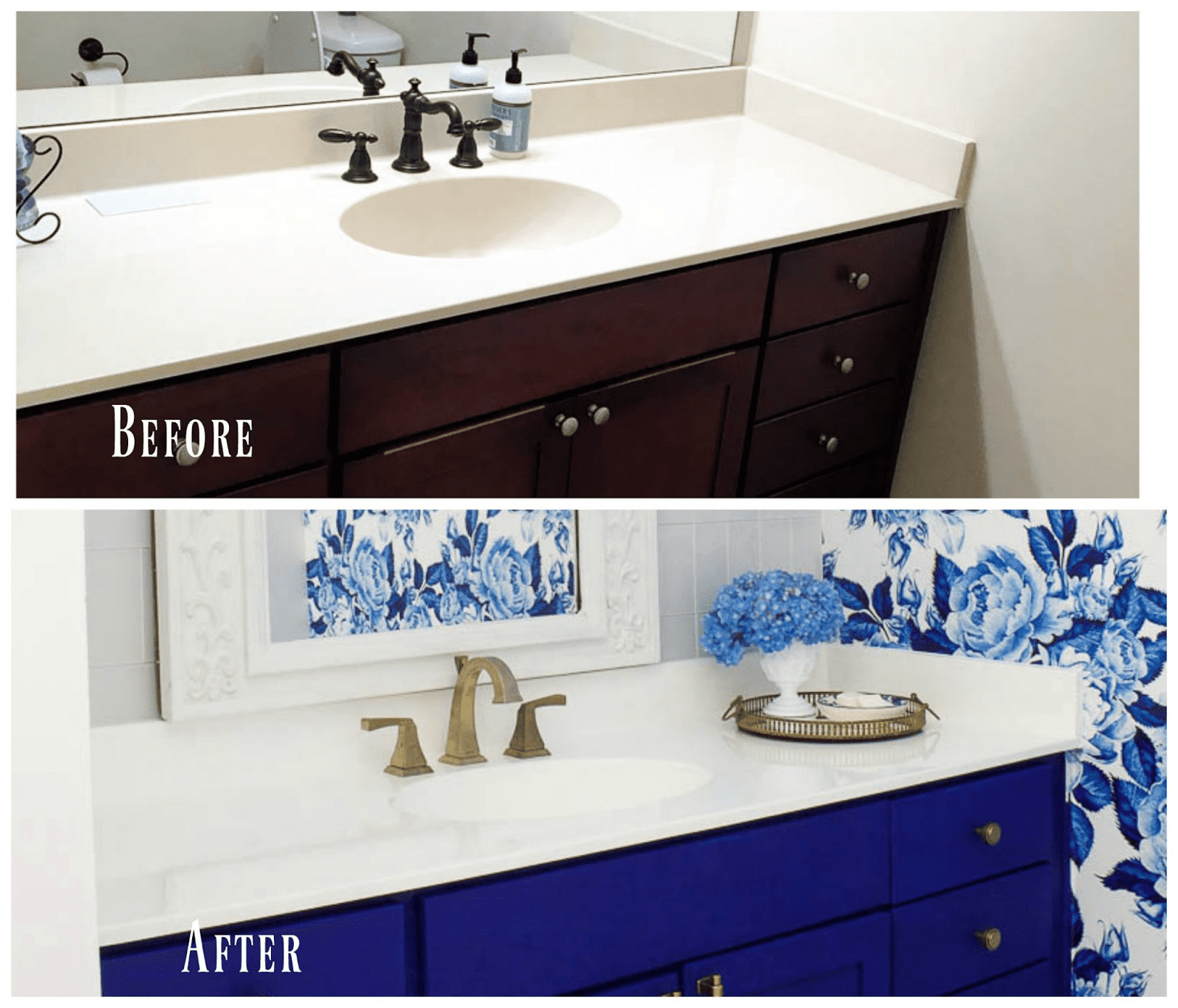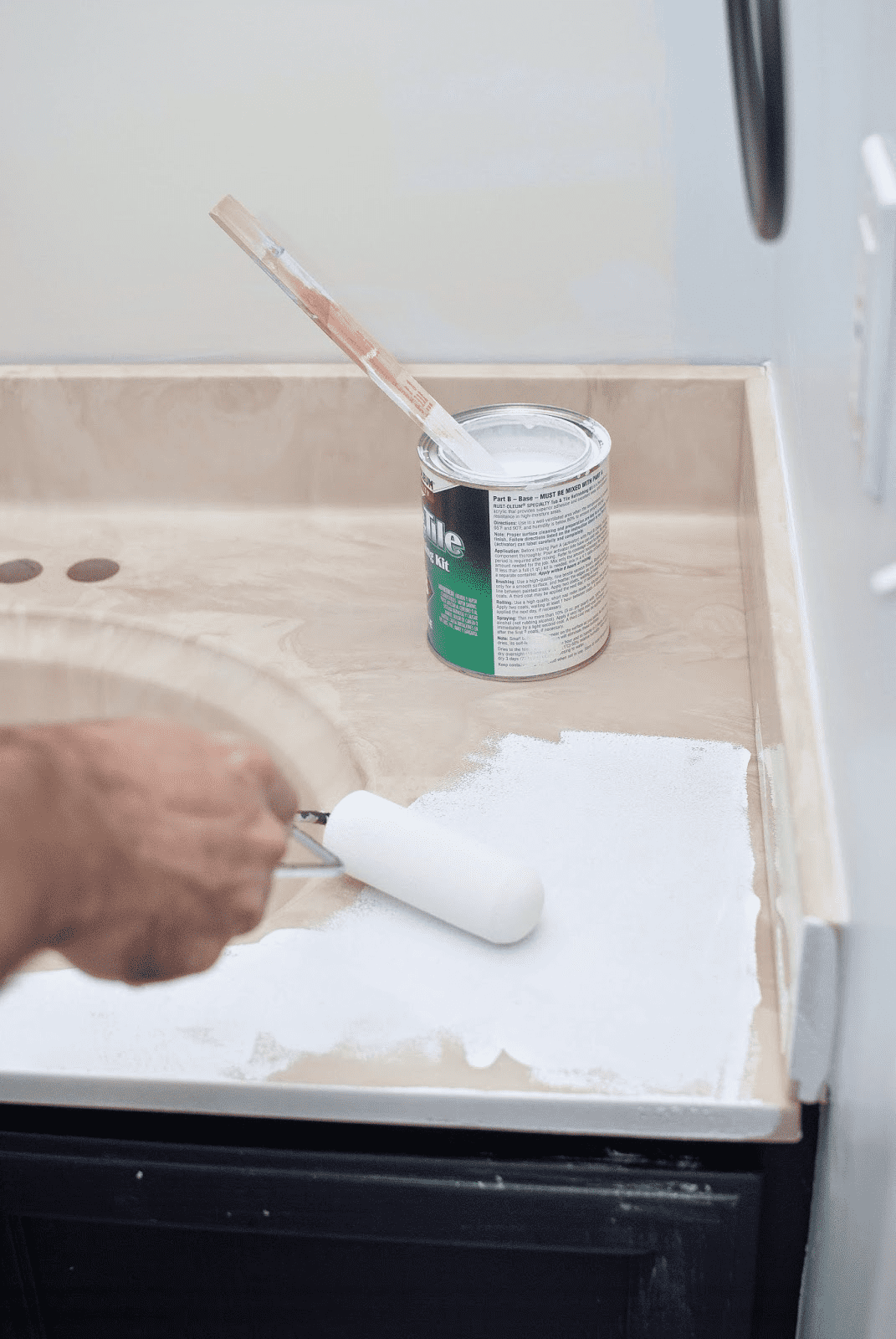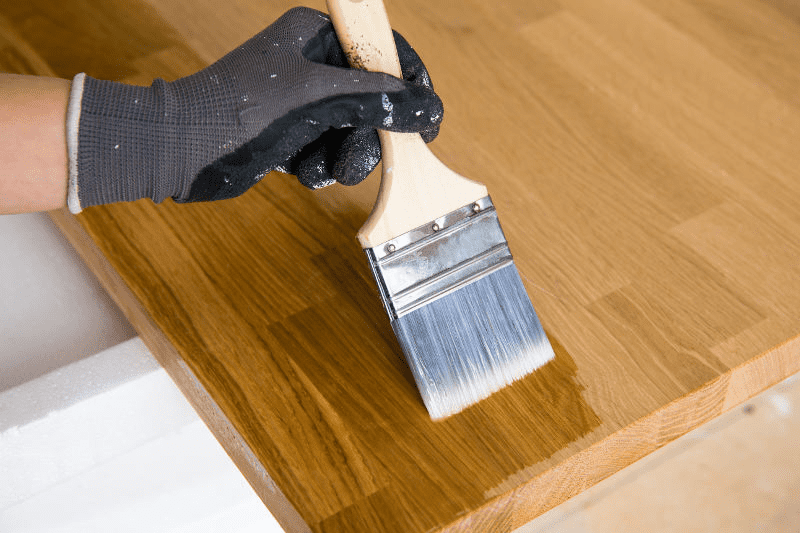Are you tired of staring at the same old bathroom countertops and want to replace them? But you don’t have the money to purchase a new one? And you’re wondering whether or not you can paint it?
As per the research, the global market for the paint and coating industry dropped down to 34% in 2020 amid the pandemic situation. However, the leading brand Sherwin-Williams recorded a sale of $4.5 billion in the last quarter of 2020 due to painting and repainting DIY activities amid the COVID situation.
Painting bathroom countertops is a time-consuming and tricky procedure, but it’s well worth it if done correctly. Additionally, it provides more aesthetic freedom and is simple to apply without the assistance of an installation or specialist.
Moreover, painting your countertops is much more budget-friendly than replacing or resurfacing them with a new one. Let’s get started!

Can you paint all countertops?
Keep in mind that you cannot paint all countertop materials easily. For instance, painting countertops that can be sanded or porous is an excellent option. In contrast, other countertops are more preferred for sanding, as paint does not stay on it for a long time.
Countertops that Can Be Painted Easily
- Laminate
- Wood
- Ceramic tile floor
- Concrete
Countertops that need Sanding and Buffing
- Quartz/Engineered stone
- Natural stone – Granite or marble
- Solid surface
Pros of painting your bathroom countertops:
Durability
Painted countertops can last for several years (5-7 years) if the owner maintains them with care. A lightly used painted bathroom counter will last around two years before needing to be repainted. However, once scratched or pierced, the thin top layer of a painted countertop may only be covered, not sanded.
Affordable
Painting your bathroom countertop is a quick, easy, and budget-friendly alternative to buying new countertops that may cost you much more. Therefore, painting your countertop to get a new look is much cheaper than replacing or resurfacing them.
Cons of painting your bathroom countertops:
High maintenance
Painted countertops need extra care and high maintenance; thus, you will have to be careful with not scrubbing or putting harsh objects on them. This is because it could peel off the layer of paint.
This is because a painted countertop is more prone to getting damaged than a solid surface countertop that is not painted.
Time-consuming
Painting your countertops is a very detail-oriented task, as it needs great patience and time to mimic exactly the natural texture, color, and pattern of a countertop.
Thus, you may have to take some days off of your schedule to complete the task correctly.
Not an option for all countertop materials
As mentioned above, only some countertops can be painted.
How to paint your countertops?
Things Needed for painting
Equipment / Tools
- Drop cloth
- Plastic sheeting
- Painter’s tape
- Latex or nitrile gloves
- Oscillating electric hand sander
- #220 and #320 grit sandpaper
- Shop vacuum with a brush attachment
- Tack cloth
- Sealant
Materials
- Waterproof paint
- Sandpaper
- Paint Roller
- Clear satin oil-based interior polyurethane spray
- TSP (tri-sodium phosphate cleaner)
Method of painting your countertops
Painting your countertop can be an easy DIY solution if you research and have a brief idea. Here is a step-by-step guide to successfully painting your bathroom countertop.
Step 1: Preparing the countertop surface
Remove anything affixed to the countertop that will not be painted, such as the bathroom sink bowl and faucet. If you can’t get rid of something, wrap it in painter’s tape to keep it clean.
Make sure your counter is clean. Before continuing, wipe with warm soapy water and allow to dry completely. To avoid moisture getting under the paint, you must let it dry.
Once you have cleaned the slab using TSP and removed the stuff, remove the countertop from the base. Because airborne particulates are challenging to control, removing the countertop and placing it in a well-ventilated area is highly suggested.
Step 2: Apply primer
Scuff up the countertop with a light sanding to create a porous paint-ready surface. Using the shop vacuum, remove the dust. After that, use a tack cloth to rub off the surface lightly. Sand the countertop with 220 grit sandpaper, then #320 grit sandpaper, then wipe away any dust with a damp rag. Allow it to dry again before proceeding.
Prepare the painting surface with acrylic primer. Use a flash-bond primer designed for high-gloss or gloss surfaces. After the first coat of primer has dried, apply a second coat and wait for it to dry.
Step 3: Apply paint
It’s time to paint after you complete applying two-layer of the primer. Apply two to three applications of latex satin or semi-gloss enamel paint. Using the paint roller, properly paint the countertop. Use only a light coat of paint. Heavy applications take longer to cure and frequently result in rough or bubbled paint.
Make sure to let the paint dry completely between applications once more.

Step 4: Sand and apply topcoat
Apply a transparent acrylic finishing coat to the painting once done. Acrylic in a semi-gloss or satin finish will be more scratch and wear-resistant.
Using clear polyurethane spray, coat the entire surface. Apply three coats of polyurethane at the very least. For a satin finish, sand with #320 grit sandpaper one last time.
Step 6: Let it dry
As the paint cures and sets, be patient with it for a few days.
Step 7: Seal the Countertop
Certain countertop materials, such as granite, need an extra protective layer to maintain the countertop layer. You can do this by sealing the surface. Therefore, once you finish painting the countertop, make sure to seal your bathroom countertop to protect it for the long run.
As you might know, granite is a porous material, and thus liquids and acidic substances may seep through it and damage the painted layer of the countertop material.
Therefore you should seal the material to maintain your countertops looking their best and to prevent them from scratches, stains, and general dullness throughout their lifetime.
What type of paint can you use on your bathroom countertop?
You can perfectly paint the bathroom vanity with oil, latex, or chalk-based paints. Oil paint has a tough finish that resists scratching and chipping, but it has a strong odor that makes working with it difficult. Because latex paints are water-based, they are less sticky and easier to clean.

Many people recommend using a water-based acrylic primer, paint, and topcoat. Acrylic paint that dries to give the firm surface needed for heavy-use areas like countertops is cleaner and odor-free than water-based acrylic paint.
How often can you repaint?
Are you one of those people that easily stop liking some of their countertop designs quickly and wonder if you can repaint your bathroom more than once?
Fortunately, you can repeat this procedure as many times as you want. For instance, people enjoy mixing and matching colors. Also, you can change the color of your bathroom countertop at any moment if you want to. So, choose a color and start painting. You may be rather inventive.
What is the cost of painting your bathroom countertop?
According to HomeAdvisor, the average cost of painting your bathroom countertops nearly comes to around $250 per square ft, including labor and materials. It may range between $60 -$600, depending on the complexity of the painting required.
Additionally, the cost may vary depending on the countertop material that you wish to paint.

![Granite Vs. Marble Vs. Quartz Countertops [12 Differences+Pros & Cons] Granite Vs. Marble Vs. Quartz Countertops [12 Differences+Pros & Cons]](https://houseadorable.com/wp-content/uploads/2022/03/quartz-marble.jpg)
![Granite vs. Laminate Countertop [Pros and Cons+10 Key Differences] Granite vs. Laminate Countertop [Pros and Cons+10 Key Differences]](https://houseadorable.com/wp-content/uploads/2022/03/Granite-vs.-Laminate.jpg)
![How Much Does It Cost to Build a Kitchen Island? [Custom Made+DIY] How Much Does It Cost to Build a Kitchen Island? [Custom Made+DIY]](https://houseadorable.com/wp-content/uploads/2022/03/cost-of-kitchen-island.jpg)
![What Are Kitchen Sinks Made Of ? [13 Types+Pros & Cons] What Are Kitchen Sinks Made Of ? [13 Types+Pros & Cons]](https://houseadorable.com/wp-content/uploads/2022/01/Sink-MAterial.jpg)
![16 Types of Kitchen Faucets Explained [With Pros + Cons] 16 Types of Kitchen Faucets Explained [With Pros + Cons]](https://houseadorable.com/wp-content/uploads/2023/02/Roca_griferia_cocina_mencia_negro_DEF_900x505_acf_cropped-1@2x-250x250.jpg)
![Ceramic vs Stainless Steel Sink [A Detailed Analysis] Ceramic vs Stainless Steel Sink [A Detailed Analysis]](https://houseadorable.com/wp-content/uploads/2021/12/Ceramic-vs-ss.jpg)

![How to Identify Kitchen Faucet Brand [6 Techniques To Know] How to Identify Kitchen Faucet Brand [6 Techniques To Know]](https://houseadorable.com/wp-content/uploads/2023/02/GettyImages-1177440335-0210e69740fd4045ab6a88f1588e9f4f-1-250x250.jpg)